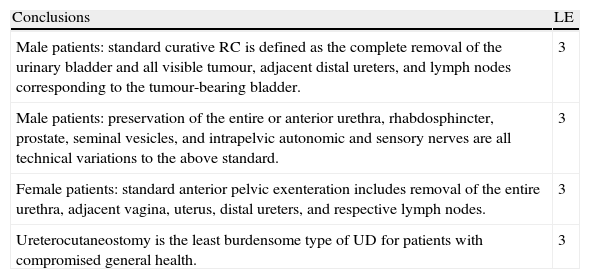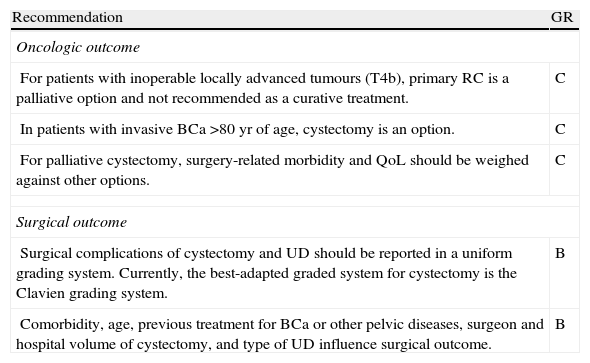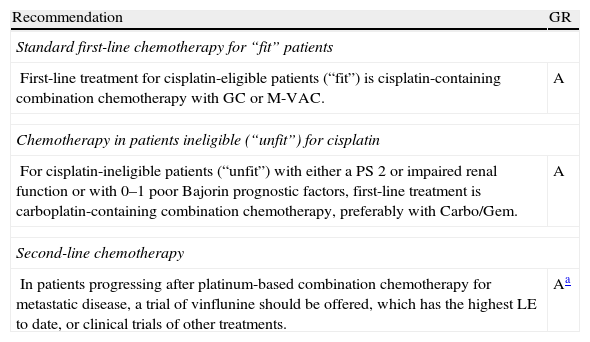New data regarding treatment of muscle-invasive and metastatic bladder cancer (MiM-BC) has emerged and led to an update of the European Association of Urology (EAU) guidelines for MiM-BC.
ObjectiveTo review the new EAU guidelines for MiM-BC with a specific focus on treatment.
Evidence acquisitionNew literature published since the last update of the EAU guidelines in 2008 was obtained from Medline, the Cochrane Database of Systematic Reviews, and reference lists in publications and review articles and comprehensively screened by a group of urologists, oncologists, and a radiologist appointed by the EAU Guidelines Office. Previous recommendations based on the older literature on this subject were also taken into account. Levels of evidence (LEs) and grades of recommendations (GRs) were added based on a system modified from the Oxford Centre for Evidence-based Medicine Levels of Evidence.
Evidence synthesisCurrent data demonstrate that neoadjuvant chemotherapy in conjunction with radical cystectomy (RC) is recommended in certain constellations of MiM-BC. RC remains the basic treatment of choice in localised invasive disease for both sexes. An attempt has been made to define the extent of surgery under standard conditions in both sexes. An orthotopic bladder substitute should be offered to both male and female patients lacking any contraindications, such as no tumour at the level of urethral dissection. In contrast to neoadjuvant chemotherapy, current advice recommends the use of adjuvant chemotherapy only within clinical trials. Multimodality bladder-preserving treatment in localised disease is currently regarded only as an alternative in selected, well-informed, and compliant patients for whom cystectomy is not considered for medical or personal reasons. In metastatic disease, the first-line treatment for patients fit enough to sustain cisplatin remains cisplatin-containing combination chemotherapy. With the advent of vinflunine, second-line chemotherapy has become available.
ConclusionsIn the treatment of localised invasive bladder cancer (BCa), the standard treatment remains radical surgical removal of the bladder within standard limits, including as-yet-unspecified regional lymph nodes. However, the addition of neoadjuvant chemotherapy must be considered for certain specific patient groups. A new drug for second-line chemotherapy (vinflunine) in metastatic disease has been approved and is recommended.
Han surgido nuevos datos sobre el tratamiento del cáncer de vejiga con invasión muscular y metastásico (CVIMM) que han llevado a una actualización de la Guía Clínica de la Asociación Europea de Urología (European Association of Urology, EAU) del CVIMM.
ObjetivoRevisar la nueva Guía Clínica de la EAU sobre el CVIMM con un enfoque específico en el tratamiento.
Adquisición de evidenciaLa literatura nueva publicada desde la última actualización de la Guía Clínica de la EAU en 2008 se obtuvo de Medline, la Base de Datos Cochrane de Revisiones Sistemáticas y listas de referencia en publicaciones y artículos de revisión y se examinó exhaustivamente por un grupo de urólogos, oncólogos, y un radiólogo designado por la Oficina de Guías Clínicas de la EAU. También se tuvieron en cuenta recomendaciones previas basadas en la literatura anterior sobre este tema. Se añadieron los niveles de evidencia (NE) y grados de recomendación (GR) basándose en un sistema modificado del Centro de Medicina Basada en la Evidencia de Oxford.
Síntesis de evidenciaLos datos actuales demuestran que la quimioterapia neoadyuvante junto con la cistectomía radical (CR) es recomendable en ciertas constelaciones de CVIMM. La CR sigue siendo el tratamiento básico de elección en enfermedad invasiva localizada para ambos sexos. Se ha intentado definir el grado de cirugía en condiciones estándar en ambos sexos. Se debería ofrecer un sustituto vesical ortotópico a pacientes tanto masculinos como femeninos sin contraindicaciones tales como ausencia de tumor al nivel de la disección uretral. En contraste con la quimioterapia neoadyuvante, actualmente se recomienda el uso de quimioterapia adyuvante únicamente en ensayos clínicos. La terapia preservadora de la vejiga multimodalidad en la enfermedad localizada se observa actualmente sólo como una alternativa en pacientes seleccionados, bien informados y acatadores para los que la cistectomía no se plantea por razones médicas o personales. En la enfermedad metastásica, el tratamiento de primera línea para los pacientes en condiciones suficientes para soportar el cisplatino sigue siendo la poliquimioterapia con cisplatino. Con la llegada de vinflunina, la quimioterapia de segunda línea se ha vuelto disponible.
ConclusionesEn el tratamiento del cáncer de vejiga (CV) invasivo localizado, el tratamiento estándar sigue siendo la extirpación quirúrgica radical de la vejiga dentro de los límites estándar, incluyendo los ganglios linfáticos regionales aún sin especificar. Sin embargo, la adición de la quimioterapia adyuvante debe ser considerada para ciertos grupos de pacientes específicos. Se ha aprobado y se recomienda un nuevo medicamento para la quimioterapia de segunda línea (vinflunina) en la enfermedad metastásica.















